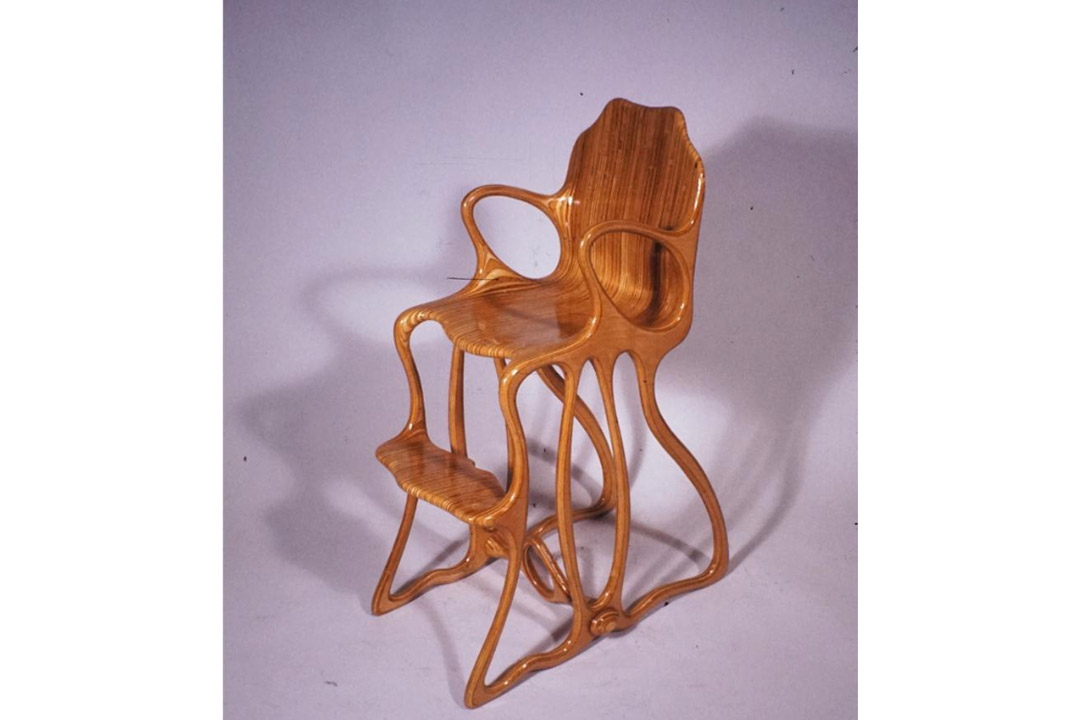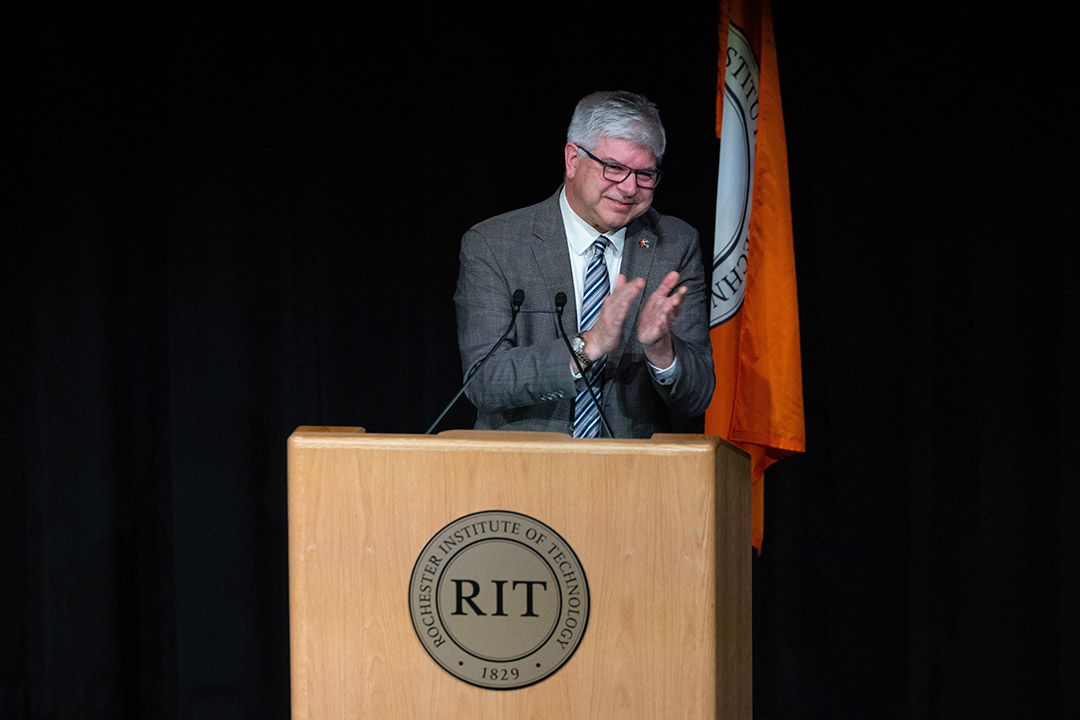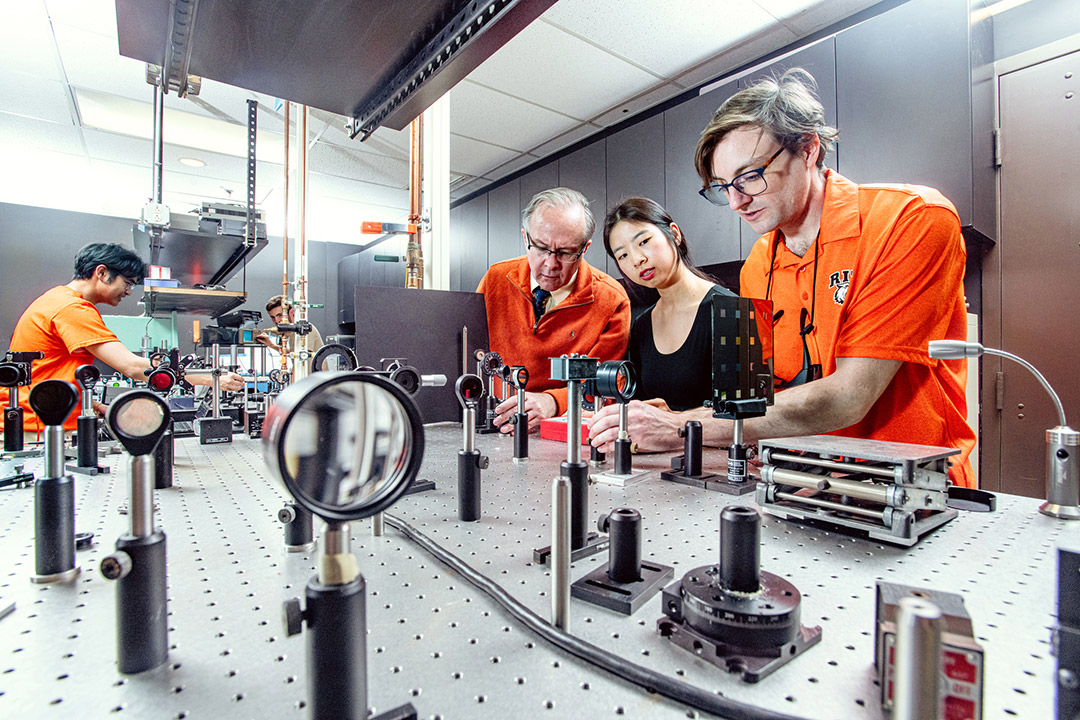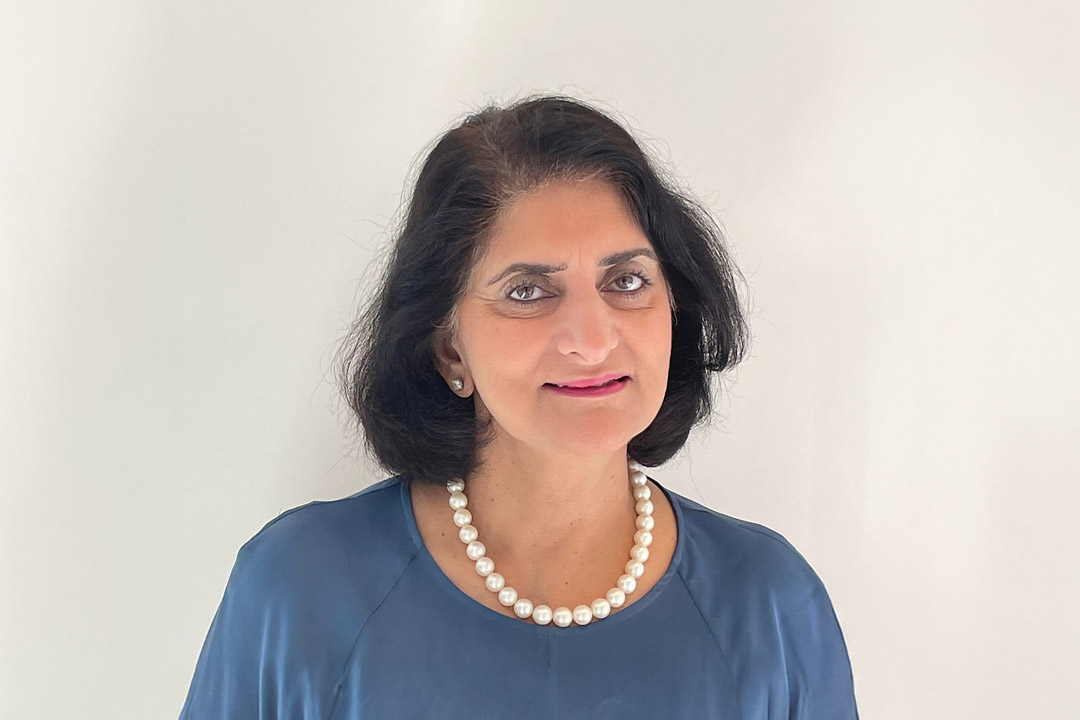Digital anatomy table gives RIT’s physician assistant BS/MS program a high-tech teaching tool
A digital anatomy table programmed with dynamic medical simulations is changing how RIT physician assistant students learn about the human body.
Three-dimensional simulations modeled on real cadavers allow students to understand how the body functions as a system and deteriorates from disease.
The simulated cadaver table manufactured by Anatomage Inc. arrived early in the fall semester, and students are already using it to supplement their courses.

Traci Westcott/RIT
RIT physician assistant lecturer Christopher Montanaro, center, quizzes physician assistant students Kaitlyn Bockelman, left, and Katrina Breen, right, on a digital anatomy table.
Justin Koplinka, a third-year PA student from Fairport, N.Y., is learning about the heart in his clinical medical sciences class and is excited to use the Anatomage table to help him understand how the muscle functions and how to read EKG signals that trace the electrical pathways through the heart.
Each week, Koplinka and his classmates study hundreds of static medical slides from two-dimensional photographs and drawings. The dynamic medical visualization will help them understand the context, he said.
“It’s helpful to be able to visualize everything and to connect what we’re learning in pathology class to what we’re learning in clinical medical class,” Koplinka said. “I could use the table to see exactly how the heart is working and what the EKG would look like, so it’s a way to visualize all the different heart abnormalities.”
The equipment arrived early in the fall semester and physician assistant lecturer Christopher Montanaro ’10 (physician assistant) has immersed himself in learning how to use it himself and then teach faculty and students. He has programmed the table with scenarios from the software’s library of actual medical cases that support the PA program’s curriculum.
Students can download the mobile app and use the software on their cell phones and tablets. Montanaro encourages them to explore the learning modules, tests, and games, which can provide refreshers, especially for the fifth-year students doing their clinical internships.
“When they’re about to go on a clinical rotation, say surgical rotation, and they know they will be removing a gallbladder on a patient, for instance, they can go to the GI section and review it in detail and see it in 3D,” Montanaro said. “If they’re about to go on a big case, they can contact me and I can show them on the Anatomage table.”
The table will be in full use during the spring semester. Physician assistant students enrolled in Advanced Gross Anatomy will alternate between the cadaver lab to observe dissected bodies and the Anatomage table to practice clinical scenarios.
RIT’s cadaver lab can accommodate six specimens obtained from the University of Rochester Medical Center. The lab supports the human gross anatomy course taught by James Perkins, head of RIT’s Department of Medical Sciences, Health, and Management in the College of Health Sciences and Technology. Medical illustration majors take the course in the fall, and biomedical sciences and physician assistant students take it in the spring.
“The standard for learning human anatomy is the cadaver lab,” Montanaro said. “The Anatomage table doesn’t replace the cadaver lab, but supplements it.”
The Anatomage table is a large touch screen computer set into a waist-high table that can adjust into an upright position for a class. Images on the screen can be manipulated to change orientation and cross-sectional view.
The Anatomage software package comes with four adult cadavers modeled on actual people who have donated their bodies to science. Each body has been reconstructed to simulate a healthy form and to illustrate the transition to a diseased state down to the blood vessels.
Regional dissections based on many other cadavers show how different anatomy functions. Students learning about the cardiac system, for instance, can compare healthy and diseased hearts and corresponding EKG signals. Simulations like this help students synthesize and apply their understanding.
“When we’re teaching medicine, the mantra is ‘structure leads to function,’ and when the structure breaks down, the function breaks down,” Montanaro said. “The Anatomage table can help students start to think through it on their own. Any tool we can get to help us develop that deeper understanding, not just by memorizing, is critical.”
In addition to the cadavers and regional anatomy, the Anatomage table includes a pregnant woman to simulate child labor and birth.
“We were looking at the table right before our women’s health exam,” said Katrina Breen, a fourth-year physician assistant student from Dover, N.H. “The live birth shows all the stations throughout the birthing process. I think seeing it in a 3D format and having it be dynamic was helpful for me.”
The anatomy table also gives students context when learning to read two-dimensional medical imaging. They can pull up scans on the screen next to the body or regional dissection.
“We’re in diagnostic imaging, and it’s really interesting to see the different cuts and views,” said Kaitlyn Brockelman, a fourth-year physician assistant student from Cleveland, Ohio. “These are from real cadavers, so being able to see the different views of the pathology is very interesting. You can see the different layers of the anatomy.”
Koplinka thinks the Anatomage table will make a difference for students in the rigorous physician assistant program. Students must learn as much as they can about medicine before their fifth-year clinical rotations begin.
“A lot of us are visual learners, so having something like this at our disposal, even for a quick review, will help us a lot,” Koplinka said. “I am excited to use the anatomy table more.”
Latest All News
- RIT recognized for dedication to community and belongingRIT has been recognized with the Higher Education Excellence and Distinction (HEED) Champion Award, as announced by Insight Into Academia magazine. This marks the 12th consecutive year RIT has received the HEED Award and the 11th consecutive year of being named a champion. The HEED Award is given annually to higher education institutions that demonstrate an outstanding commitment to inclusion and belonging across campus. Awardees earn the distinction after a comprehensive review of the institution’s policies, strategies, programs, initiatives, demographics, and protocols. HEED Champions exceed expectations and often surpass goals. “RIT’s longevity in receiving this award is a testament to our ongoing commitment to making our university a welcoming, open space for people of all backgrounds,” said Keith Jenkins, vice president and associate provost for Access, Engagement, and Success. “We are honored to once again be recognized for this distinction.” As one of 62 recipients at the undergraduate level, RIT will be featured in an upcoming issue of Insight Into Academia. The publication describes itself as a leader in advancing best practices in higher education excellence and belonging. Its awards help celebrate undergraduate institutions, community colleges, health professions schools, graduate schools, and law schools. More information on the HEED Award and the magazine can be found at the Insight Into Academia website.
- RIT Archives exhibit honors early woodworking alumna Ellen SwartzA clock with a human face, a lamp base with a hidden compartment, and an Art Nouveau-inspired high chair are among the objects featured in a new RIT Archives exhibit honoring a trailblazing alumna. "Carving a Legacy" celebrates the late Ellen Swartz’s achievements as an artist and a role model for women woodworkers and furniture designers. The exhibit is located on the third floor of Wallace Library and is accessible until the end of the academic year. RIT Archives Furniture maker and educator Ellen Swartz graduated from RIT’s School for American Crafts in 1966. Swartz started as a violin student at the Eastman School of Music but left her studies to build and repair violins. In 1964, she applied to RIT’s School for American Crafts and, in 1966, became the first woman to graduate with an associate’s degree in woodworking and furniture design. “Ellen Swartz holds a legendary place in the College of Art and Design,” said Elizabeth Call, RIT university archivist. “At a time when women were expected to choose only from a narrow set of professions, she carved out a path in furniture making, a field virtually closed to them. Her persistence and artistry remind us how much courage it takes to change what’s possible.” Swartz completed around 200 woodworking projects, including chairs, tables, stands, magazine racks, and lamps, and sold her furniture through a Boston-based gallery. She explored working with stacked and laminated plywood and wrote about her technique in a 1977 issue of Fine Woodworking magazine. She balanced her interest in furniture making with a career in education, first as an industrial arts teacher and, later as a consultant for the Rochester City School District. Swartz, who died in 2018, had earned advanced degrees in counseling and education from the State University of New York at Brockport and from the University of Rochester. She co-authored three books about urban education and culturally informed curriculum and pedagogy, and taught at Nazareth University, Niagara University, and Pace University. The artist’s husband, Joel Swartz, a 1969 alumnus with a BFA in photography, donated the Dr. Ellen Swartz collection to the RIT Archives in 2019.
- President Sanders delivers his first State of the University AddressDespite challenges facing academia, RIT President Bill Sanders expressed confidence in the university’s strong position and readiness for the future. During his first State of the University Address on Wednesday, Sanders said RIT will continue to deliver a world-class education, support groundbreaking research and scholarship, and be a destination for talent from every corner of the globe. “Through strategic actions and a visionary approach, we are positioning ourselves not simply to weather the uncertainty but to stay ahead of it and lead,” Sanders said. “We will do this by thinking strategically, acting on our aspirations, being willing to make difficult choices, and being nimble. We will do all of these things while remaining true to our community’s values.” Sanders, who became RIT’s 11th president on July 1, outlined the university’s many accomplishments from the past year. Some highlighted achievements include:A record $105 million in new, sponsored research funding in fiscal year 2025. The welcoming of more than 3,000 undergraduate, 471 master’s, and 110 Ph.D. students to Rochester’s campus this fall. A strong global presence with 103 partnerships across 53 countries and increased enrollment at RIT’s global campuses in Dubai, Croatia, and Kosovo. The naming of the new Tiger Stadium as the Thomas Fearey Judson Jr. Stadium after a significant contribution from the Pike and Judson families towards the $30 million facility. A record fundraising year with $46.8 million in new gift commitments. Looking ahead, Sanders noted the progress being made on the university’s strategic framework that will update the university’s mission and vision, core values, and strategic goals. That framework will be built on four pillars: transformative student experiences and success; world changing research and scholarship; community wellbeing and belonging; and a global reach and mindset. “The success of this strategic framework process depends on the collective wisdom and creativity of our entire community so we may all thrive,” said Sanders. “We are well positioned to re-invent the future.” Sanders concluded the address by encouraging the RIT community to get involved and to have a voice. He stated that the university is ready to lead with creators, makers, innovators, teachers, researchers, and entrepreneurs who will shape the future for good at a time of disruption. “Our university community is on to something that is truly exceptional,” he said. “I want to make sure RIT continues to be a place where all can explore boldly, fail safely, and succeed spectacularly.” The State of the University Address, held on campus in Ingle Auditorium, also included remarks by Prabu David, provost and senior vice president for Academic Affairs; Richard Zanibbi, chair of Faculty Senate; Jeremy Zehr, vice chair of Staff Council; Rafael Gilboa, president of Student Government; and Keith Jenkins, vice president and associate provost for Access, Engagement, and Success. Read the full text of President Sanders’ State of the University Address.
- RIT unveils Judson Stadium, honoring a family legacyRochester Institute of Technology has named its new athletics venue Thomas Fearey Judson Jr. Stadium. The new stadium name honors the extraordinary legacy of former RIT Trustee Tom Judson, Pike Construction Services, the Judson family, and their century-long impact on the university. Formerly known as Tiger Stadium, the $30 million, 38,828-square-foot facility broke ground in April 2024 and is slated for completion in January 2026. It will serve as the new home for RIT’s lacrosse and soccer programs for the men’s and women’s teams. The stadium’s new name honors a transformative gift from Thomas F. Judson Jr.; his wife, Ebets; their son, Rufus; and their company, Pike Construction Services. The family’s connection to RIT spans generations. When Judson joined the Board of Trustees in 1984, he followed in the footsteps of his grandfather, John D. Pike, who joined in 1930, and his father, Thomas F. Judson Sr., who joined in 1961. Today, Rufus Judson continues the family legacy as CEO of Pike, marking the fourth generation of leadership, philanthropy, and impact on the RIT community and campus. “Judson Stadium is more than a venue—it’s a tribute to a family whose values of service, leadership, and generosity have helped define RIT’s transformation,” said RIT President Bill Sanders. “We are deeply grateful to Pike and the Judson family for their enduring commitment to our students, our campus, and our future.” Judson Stadium will feature:Seating for 1,180 spectators, plus standing room and hospitality space Locker rooms for lacrosse and soccer teams A state-of-the-art training room with hot/cold tubs and exam tables A glass-walled hospitality room overlooking the field A media suite for broadcast and communications Concession areas A partially covered outdoor concourse for events and fan engagement “I am deeply proud to support this project and to see how far RIT Athletics has come,” said Tom Judson. “Having played lacrosse in college, I know the impact that competing at a high level can have on a student’s life. The growth and success of RIT’s student-athletes reflect the university’s ambition and drive, and we are honored to help provide a stadium worthy of their talent and dedication.” Designed by LaBella Associates with support from Populous, and managed by Pike Construction Services, the stadium will be one of the first structures visitors see when arriving on campus—symbolizing RIT’s commitment to excellence, innovation, and community. “This facility will elevate our athletics programs and provide a premier experience for student-athletes and fans alike,” said Jacqueline Nicholson, executive director of Athletics. “Judson Stadium will stand as a lasting legacy for generations to come.” A formal dedication ceremony will be held on April 18, 2026.
- RIT sets record for sponsored research fundingRIT is celebrating a record year for sponsored research funding in fiscal year 2025, receiving $105 million. Milestones include reaching a new record for National Science Foundation awards at more than $21 million. Additionally, RIT faculty submitted 30 NSF CAREER Award submissions this past year, which is another record. Assistant Professor Shima Parsa from the College of Science and Associate Professor Rui Liu from the Kate Gleason College of Engineering are the most recent recipients of the prestigious NSF CAREER Award honors. RIT received approximately 72 percent of its awards from federal funding agencies. “The breadth and depth of our university researchers showcases the innovation that continues to propel RIT forward and move us into a new category of research excellence,” said Ryne Raffaelle, vice president for Research. “These new levels of sponsored activity demonstrate that the research work of our faculty is worthy of national and international recognition, even in such a challenging times for federal research funding.” Kate Gleason College of Engineering led the RIT colleges by receiving more than $20 million in new sponsored research awards, and the College of Science led in the number of research funding proposals submitted with more than 200 throughout fiscal year 2025. “Our faculty is conducting research on the cutting edge of advanced manufacturing, semiconductor and quantum technologies, biomedical and healthcare engineering, artificial intelligence, and much more,” said Doreen Edwards, dean of the College of Engineering. “In addition, our master’s and Ph.D. students are working side-by-side with our faculty. This environment is rich with opportunities to develop the next generation of engineers who will carry this research to the next level.” Additionally, several of the university’s interdisciplinary research centers, including the K-12 University Center, Battery Development Center, NanoPower Research Labs, and Personalized Healthcare Technology that draw faculty from across colleges and disciplines to create solutions for some of society’s current challenges, each exceeded $7 million in sponsored funding. Added Raffaelle: “Looking ahead, we are energized and driven to advance and support our faculty researchers to win research awards that allow them to advance their disciplines and create technologies and findings that have the potential to improve our world.”
- Lecture from tech executive will explore critical thinking in an AI-powered worldDistinguished engineer Anshu Kak doesn’t believe that artificial intelligence (AI) will replace people. Instead, it can augment human capabilities—but the key is understanding how to leverage it effectively. Kak, the global vice president for Google Cloud Platform and Data/Private AI Practice at Kyndryl, will headline the 2025 Eugene H. Fram Signature Lecture in Critical Thinking at RIT. The highly accomplished C-level executive will offer insights into leadership and technology. Her presentation, “Augmented Leadership: Critical Thinking in the Age of GenAI,” will be held from 3:30 to 5 p.m. Tuesday, Sept. 30, in RIT’s Ingle Auditorium, Student Alumni Union. The talk is free and open to the public. There will be a light reception in Fireside Lounge after the lecture. Kak’s presentation will focus on the critical role of leaders as orchestrators of intelligent systems and facilitators of seamless human-AI collaboration. She will explore how to navigate complexities of autonomous agents, cultivate critical thinking in the context of industry-relevant use cases, and drive informed, strategic decisions. “Critical thinkers can continually adapt to rapidly evolving technological, aesthetic, and social environments, and manifest new ideas, both individually and collectively,” said Jennifer Schneider, professor, senior director of Integrated Curriculum, and Eugene H. Fram Chair of Applied Critical Thinking. “We must think critically to assess all our technologies—including AI and the information it is built upon—as they integrate into and across our lives.” Attendees to this year’s Fram Lecture will learn how to lead effectively in an era defined by continuous AI evolution, empower teams, and foster AI-driven decision-making. As a technical executive, Kak has more than 25 years of experience at tech giants Google, IBM, and GE. She led Google Cloud’s global Principal Architect community and spearheaded Google’s Solution Design Method, an approach grounded in critical and design thinking that reflects her commitment to solving complex problems through thoughtful, human-centered leadership. The annual Eugene H. Fram Signature Lecture in Critical Thinking is part of the campuswide Applied Critical Thinking initiative, which integrates critical thinking improvement in classes and community life and promotes it through events. The Eugene H. Fram Chair was founded in 2011 through a donation from an RIT alumnus who wished to recognize the impact of Eugene H. Fram, a professor emeritus of marketing. Fram taught at RIT for 51 years and was a chair in Saunders College of Business. Register online to attend the lecture.













